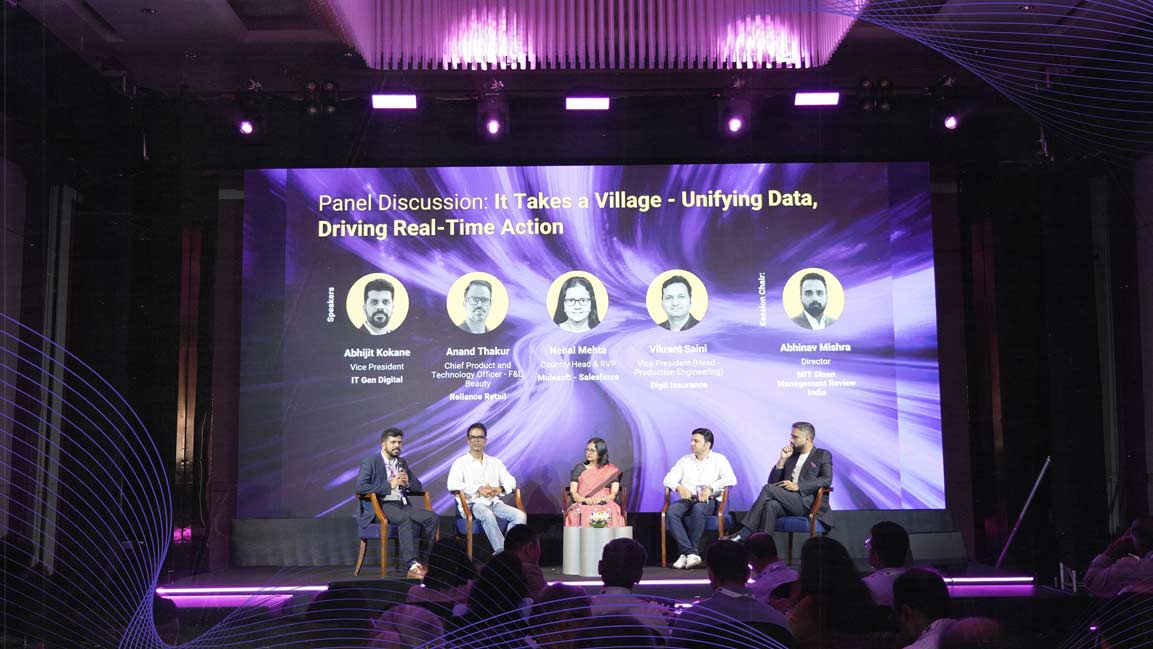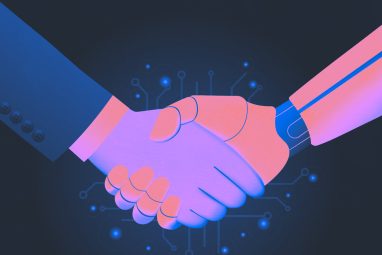How AI and Data Are Rewiring How India Does Business
From cybersecurity to AI governance Indian tech executives outline the roadmap for digital transformation at the Bengaluru edition of the Strategy Shift Forum.
Topics
News
- Nexus Closes Eighth Fund at $700 Million for Early-Stage Bets in India and US
- Amazon to Pump $12.7 Billion into India’s AI and Cloud Expansion
- Anthropic Debuts Interviewer Tool to Understand How People Really Use AI
- IPL Tops Google’s Search List for 2025 as AI Breaks Into India’s Top 10
- TeamLease Names Suparna Mitra MD & CEO in Leadership Overhaul
- Apple Loses Top UI Designer as Alan Dye Joins Meta

As enterprises grapple with the vast complexity of integrating fragmented data streams and deploying artificial intelligence at scale, technology leaders gathered in Bengaluru for the Strategy Shift Forum, hosted by MIT Sloan Management Review India and powered by Salesforce, to explore how securing trust, ensuring compliance, and unifying systems are foundational to unlocking real-time intelligence and automation-driven agility.
Abhijit Kokane, Vice President of IT at Gen Digital, set the tone by emphasizing cybersecurity as foundational to data unification. “Three key pillars are trust, resiliency, and compliance,” he said. “When I say trust, you probably have heard of zero trust. Defining that architecture to ensure there is trusted access to data is essential… Resiliency means how well you recover from incidents… And compliance means managing data according to GDPR (EU’s General Data Protection Regulation), DPDP (India’s Digital Personal Data Protection), and other regulations.”
From a retail perspective, Anand Thakur, Chief Product and Technology Officer for F&L, Beauty at Reliance Retail, highlighted the critical role of customer data platforms (CDPs) in powering marketing and inventory decisions. “What is extremely important is to have a very good CDP with AI-based ID resolution capabilities,” he said. “We achieved a match rate for Google and Meta of around 80 percent, up from 50, thanks to AI.” Using 350 million customer profiles, Reliance performs 360-degree personalization in real time, optimizing campaigns and inventory planning at granular local levels.
Nehal Mehta, Country Head and Regional Vice President of MuleSoft at Salesforce, outlined how integration platforms unlock data from fragmented legacy systems, enabling enterprises to orchestrate actions in real time. “We specialize in API-led connectivity. You can connect to any system, on premises or cloud, including legacy core banking,” he said. “Combining integration, API management, and process automation gives enterprises a real-time and unified view.”
Vikrant Saini, Vice President and Head of Production Engineering at Digit Insurance, emphasized reliability in real-time underwriting systems. “We set high-level goals, such as 99.99% availability,” he said. “Then all teams derive their OKRs (Objectives and Key Results) from that. Reliability and trustworthiness are the foundations.” The team uses AI-generated code recommendations to accelerate problem resolution, reducing downtime and improving product delivery speed.
Central to the discussion was the challenge of managing AI adoption responsibly without overwhelming teams. Kokane described AI and automation as “highly skilled interns who don’t sleep, don’t complain, and tirelessly review logs.” Yet he advised caution: “Start small. Choose explainable AI use cases and invest in training your people. Mistakes will happen, so accept them and learn.”
The conversation also tackled the complexity of organizational change. Anand Thakur stressed that “technology is easy” but “change management is far more complex.” Reliance Retail moved from a centralized data governance model to a federated structure empowered by AI to maintain master data quality and flag anomalies.
Neil Thompson, Director of the Future Tech Research Project at MIT, delivered the session’s masterclass on AI automation’s current capabilities and future trajectory. He began by addressing widespread anxiety over AI’s impact on jobs, describing differing economists’ predictions ranging from 5% to 50% of jobs potentially automated over the next decade.
Thompson cautioned that AI models perform unevenly depending on task complexity and data availability. “AI tends to be quite good at short, narrow tasks, but its performance drops exponentially as workflows grow more complex,” he said. He urged enterprises to build hybrid systems where humans review AI output to catch errors, noting that “almost always you need a catch to ensure quality.”
Highlighting real-world examples, he pointed to a European supermarket whose initial AI-driven inventory forecasting was a third more accurate but stalled over high costs. “You need to understand the business value versus the cost of AI investment to make the right choice,” he advised.
Thompson also explained the “scaling laws” of AI—how larger models with more data and compute power dramatically improve capabilities but also quickly increase costs, often requiring strategic choices about when and where to deploy AI.
Emphasizing the human component, Thompson said, “AI is not omnipotent; you need to design processes, testing, and governance to manage its risks and limitations.” He introduced MIT’s AI Risk Repository (ai-risk.mit.edu) as a resource for organizations to understand and mitigate AI-related dangers.
The layered insights from the panel and masterclass underscored a common roadmap for Indian enterprises: unify fragmented data with secure and scalable architecture, adopt AI in manageable increments aligned with business goals, and embed robust governance and human oversight.




